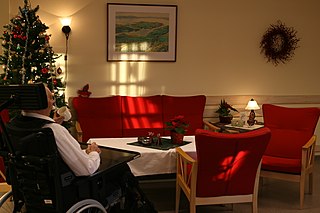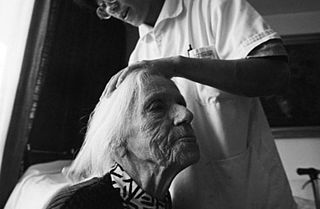 W
WGeriatrics, or geriatric medicine, is a specialty that focuses on health care of elderly people. It aims to promote health by preventing and treating diseases and disabilities in older adults. There is no set age at which patients may be under the care of a geriatrician, or geriatric physician, a physician who specializes in the care of elderly people. Rather, this decision is determined by the individual patient's needs, and the availability of a specialist. It is important to note the difference between geriatrics, the care of aged people, and gerontology, which is the study of the aging process itself. The term geriatrics comes from the Greek γέρων geron meaning "old man", and ιατρός iatros meaning "healer". However, geriatrics is sometimes called medical gerontology.
 W
WAn aging-associated disease is a disease that is most often seen with increasing frequency with increasing senescence. Essentially, aging-associated diseases are complications arising from senescence. Age-associated diseases are to be distinguished from the aging process itself because all adult animals age, save for a few rare exceptions, but not all adult animals experience all age-associated diseases. Aging-associated diseases do not refer to age-specific diseases, such as the childhood diseases chicken pox and measles. "Aging-associated disease" is used here to mean "diseases of the elderly". Nor should aging-associated diseases be confused with accelerated aging diseases, all of which are genetic disorders.
 W
WFounded in 1975, Bayada Home Health Care is an international nonprofit home health care provider. BAYADA has more than 360 offices in 23 states, with locations in Germany, India, Ireland, New Zealand, and South Korea.
 W
WCachexia is a complex syndrome associated with an underlying illness causing ongoing muscle loss that is not entirely reversed with nutritional supplementation. A range of diseases can cause cachexia, most commonly cancer, congestive heart failure, chronic obstructive pulmonary disease, chronic kidney disease and AIDS. Systemic inflammation from these conditions can cause detrimental changes to metabolism and body composition. In contrast to weight loss from inadequate caloric intake, cachexia causes mostly muscle loss instead of fat loss. Diagnosis of cachexia can be difficult due to the lack of well-established diagnostic criteria. Cachexia can improve with treatment of the underlying illness but other treatment approaches have limited benefit. Cachexia is associated with increased mortality and poor quality of life.
 W
WCervical spinal stenosis is a bone disease involving the narrowing of the spinal canal at the level of the neck. It is frequently due to chronic degeneration, but may also be congenital. Treatment is frequently surgical.
 W
WDementia with Lewy bodies (DLB) is a type of dementia accompanied by changes in sleep, behavior, cognition, movement, and autonomic bodily functions. Memory loss is not always an early symptom. The disease worsens over time and is usually diagnosed when cognitive decline interferes with normal daily functioning. Together with Parkinson's disease dementia, DLB is one of the two Lewy body dementias. It is a common form of dementia, but the prevalence is not known accurately and many diagnoses are missed. The disease was first described by Kenji Kosaka in 1976.
 W
WElderly care, or simply eldercare, is the fulfillment of the special needs and requirements that are unique to senior citizens. This broad term encompasses such services as assisted living, adult day care, long term care, nursing homes, hospice care, and home care. Because of the wide variety of elderly care found nationally, as well as differentiating cultural perspectives on elderly citizens, it cannot be limited to any one practice. For example, many countries in Asia use government-established elderly care quite infrequently, preferring the traditional methods of being cared for by younger generations of family members.
 W
WElite Care, based in Portland, Oregon, is an elderly care company that operates assisted living facilities in the Pacific Northwest. Their corporate offices are located in Tigard, OR, and they employ over 120 employees. As of July 2013, they housed over 110 total residents.
 W
WAn Établissement d'hébergement pour personnes âgées dépendantes is the most widespread type of French Residential care for senior citizens.
 W
WFalls in older adults are a significant cause of morbidity and mortality and are a major class of preventable injuries. The cause of falling in old age is often multifactorial and may require a multidisciplinary approach both to treat any injuries sustained and to prevent future falls. Falls include dropping from a standing position or from exposed positions such as those on ladders or stepladders. The severity of injury is generally related to the height of the fall. The state of the ground surface onto which the victim falls is also important, harder surfaces causing more severe injury. Falls can be prevented by ensuring that carpets are tacked down, that objects like electric cords are not in one's path, that hearing and vision are optimized, dizziness is minimized, alcohol intake is moderated and that shoes have low heels or rubber soles.
 W
WThe frailty index (FI) is used to measure the health status of older individuals; it serves as a proxy measure of aging and vulnerability to poor outcomes.
 W
WFrailty is a common geriatric syndrome that embodies an elevated risk of catastrophic declines in health and function among older adults. Frailty is a condition associated with ageing, and it has been recognized for centuries. As described by Shakespeare in As You Like It, "the sixth age shifts into the lean and slipper’d pantaloon, with spectacles on nose and pouch on side, his youthful hose well sav’d, a world too wide, for his shrunk shank…". The shrunk shank is a result of loss of muscle with aging. It is also a marker of a more widespread syndrome of frailty, with associated weakness, slowing, decreased energy, lower activity, and, when severe, unintended weight loss. Frailty has been identified as a risk factor for the develoment of dementia.
 W
WGeriatric dentistry is the delivery of dental care to older adults involving diagnosis, prevention, management and treatment of problems associated with age related diseases. The mouth is referred to as a mirror of overall health, reinforcing that oral health is an integral part of general health. In the elderly population poor oral health has been considered a risk factor for general health problems. Older adults are more susceptible to oral conditions or diseases due to an increase in chronic conditions and physical/mental disabilities. Thus, the elderly form a distinct group in terms of provision of care.
 W
WGeriatric trauma refers to a traumatic injury that occurs to an elderly person. The three prevailing causes of traumatic death in the elderly are falls, traffic collisions and burns.
 W
WGerontological nursing is the specialty of nursing pertaining to older adults. Gerontological nurses work in collaboration with older adults, their families, and communities to support healthy aging, maximum functioning, and quality of life. The term gerontological nursing, which replaced the term geriatric nursing in the 1970s, is seen as being more consistent with the specialty's broader focus on health and wellness, in addition to illness.
 W
WA hip protector is a specialized form of pants or underwear containing pads along the outside of each hip/leg, designed to prevent hip fractures following a fall. Recent developments include the use of double-sided adhesive films that are breathable and more comfortable to wear than specialised pants. The adhesive films are safer because they can be worn in the bath or shower, or when toileting. Hip protectors are most commonly used in elderly individuals who have a high risk of falls and hip fractures.
 W
WHome care is supportive care provided in the home. Care may be provided by licensed healthcare professionals who provide medical treatment needs or by professional caregivers who provide daily assistance to ensure the activities of daily living (ADLs) are met. In-home medical care is often and more accurately referred to as home health care or formal care. Often, the term home health care is used to distinguish it from non-medical care, custodial care, or private-duty care which refers to assistance and services provided by persons who are not nurses, doctors, or other licensed medical personnel. For terminally ill patients, home care may include hospice care. For patients recovering from surgery or illness, home care may include rehabilitative therapies.
 W
WKorian is a French company specialized in Nursing home care for the elderly, named EHPAD in France. Korian has nursing homes six European countries.
 W
WLumbar spinal stenosis (LSS) is a medical condition in which the spinal canal narrows and compresses the nerves and blood vessels at the level of the lumbar vertebrae. Spinal stenosis may also affect the cervical or thoracic region, in which case it is known as cervical spinal stenosis or thoracic spinal stenosis. Lumbar spinal stenosis can cause pain in the low back or buttocks, abnormal sensations, and the absence of sensation (numbness) in the legs, thighs, feet, or buttocks, or loss of bladder and bowel control.
 W
WNurses Improving Care for Healthsystem Elders (NICHE) is a program of the Hartford Institute for Geriatric Nursing at New York University College of Nursing, that works to achieve systematic nursing change to benefit hospitalized older patients. Founded in 1992, NICHE has evolved into a national geriatric nursing program comprising over 620 hospitals in more than 40 states as well as parts of Canada.
 W
WParkinson's disease (PD), or simply Parkinson's is a long-term degenerative disorder of the central nervous system that mainly affects the motor system. The symptoms usually emerge slowly and, as the disease worsens, non-motor symptoms become more common. The most obvious early symptoms are tremor, rigidity, slowness of movement, and difficulty with walking, but cognitive and behavioral problems may also occur. Parkinson's disease dementia becomes common in the advanced stages of the disease. Depression and anxiety are also common, occurring in more than a third of people with PD. Other symptoms include sensory, sleep, and emotional problems. The main motor symptoms are collectively called "parkinsonism", or a "parkinsonian syndrome".
 W
WParkinsonism is a clinical syndrome characterized by tremor, bradykinesia, rigidity, and postural instability. These are the four motor symptoms found in Parkinson's disease (PD), after which it is named, dementia with Lewy bodies (DLB), Parkinson's disease dementia (PDD), and many other conditions. A wide range of causes may lead to this set of symptoms, including neurodegenerative conditions, drugs, toxins, metabolic diseases, and neurological conditions other than PD.
 W
WReminiscence therapy is used to counsel and support older people, and is an intervention technique with brain-injured patients and those who appear to have "Alzheimer's and other forms of cognitive disease."
 W
WSpinal stenosis is an abnormal narrowing of the spinal canal or neural foramen that results in pressure on the spinal cord or nerve roots. Symptoms may include pain, numbness, or weakness in the arms or legs. Symptoms are typically gradual in onset and improve with bending forwards. Severe symptoms may include loss of bladder control, loss of bowel control, or sexual dysfunction.
 W
WVitreomacular adhesion (VMA) is a human medical condition where the vitreous gel of the human eye adheres to the retina in an abnormally strong manner. As the eye ages, it is common for the vitreous to separate from the retina. But if this separation is not complete, i.e. there is still an adhesion, this can create pulling forces on the retina that may result in subsequent loss or distortion of vision. The adhesion in of itself is not dangerous, but the resulting pathological vitreomacular traction (VMT) can cause severe ocular damage.